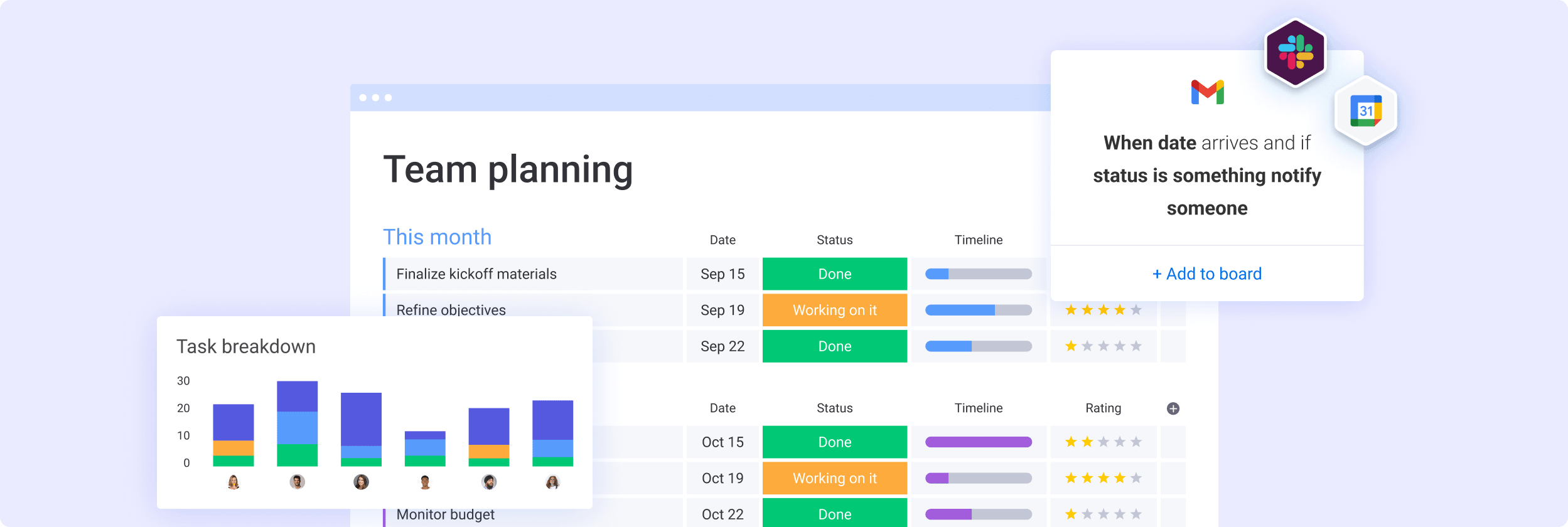Your team is getting started on a new project and the goals and end products are clear. You have a plan to meet the deadline and make the best, most professional final product possible. But then, all of a sudden, the project changes in size, budget, features, or even timeline. This is scope change, a stressful and potentially overwhelming part of project management.
In this blog we’ll look at what scope change is, why it’s important to handle it strategically, and how a project management tool such as monday.com can help scope change feel manageable.
What is scope change?
Scope change is an official decision to change the scope of a project. It must be agreed on by both (or all) sides involved in order to move forward.
Scope change can include changing:
- A feature (expanding or reducing)
- Cost
- Budget
- Timeline
Scope change occurs in the project execution phase of project management and can cause the entire project to become disorganized, and in certain cases cause massive frustration for those involved. This is because a project that has been planned well will naturally be disrupted by scope change, no matter its size. Therefore, having a plan and strategy to handle scope change is critical for any team and project.
Why is it important to handle scope change strategically?
Scope change happens, even to those who try to avoid it at all costs. The project management process is inevitably dynamic, and good project managers and teams need to learn to deal with scope change when it comes their way.
The most important thing is to approach scope change strategically. When scope change isn’t handled correctly, it can quickly get out of control, forcing teams to understand the new scope and make a new plan ASAP.
When scope change happens it’s best to take the following steps:
- Take a step back from the project to understand what the current needs are
- Reevaluate the timeline, budget, team members needed, etc.
- Make a new plan for the project
- Get back to work
Scope change vs. scope creep
Differentiating scope change from scope creep is important when making a game plan of how to proceed.
Scope creep is when a project slowly grows behind the original scope, without having made an official decision to make a change to a project. Scope creep is much more difficult to manage as it isn’t agreed upon in advance and usually involves a lack of planning, a change of budget, etc. For example, a client may ask to add multiple new features to a project. This is scope creep.
Examples of scope change
Different types of projects can include different types of scope change. In general, scope change is related to a defined change in scope, whether it be related to budget, functions of a project, goals, or specific deliverables.
Some examples of scope change include:
- Adding new deliverables
- Lowering the budget of a project and therefore removing certain features or parts of the project
- Deadline changes which can affect the ability to complete all parts of the project on time
The most important part of scope change is understanding how the change will affect the final product and if it is possible in the given time frame.
How to use a project management tool to manage scope change
A project management tool is critical for handling scope change. This is because scope change requires reworking project plans and strategies as well as timelines and budgets.
When you use a project management tool such as monday.com, you can make adjustments to your project plan and get an overview of the impact right away. This is possible by using the timelines, project overviews, dashboards, Workload Overview, and much more.

- With the Workload Overview, you can get a clear picture of who is working on what and which team members can handle more tasks when dealing with scope change.
- Project dashboards will give you a birds-eye, real-time view of your project, so you can make changes accordingly, adjust schedules, budgets, and goals, and never lose track of the finish line.
- Using monday.com’s dependencies feature allows you to keep different parties in the loop when it’s their turn to start working on a part of the project. This is critical when timelines shift.
When you have a project management tool that is set up correctly, scope change doesn’t feel overwhelming because you are able to build and execute a new plan ASAP.
Frequently asked questions
What is scope change in project management?
Scope change is an agreed-upon change in the scope of a project. Scope change typically takes place in the execution phase of a project, and can relate to budget, adding or removing certain parts of a project, and more. Scope change, as opposed to scope creep, is agreed upon in advance of making the change.
Why is project scope change in project management important?
Tackling scope change as soon as it happens and making a new plan for your project is critical to any project’s success. In many cases, scope change can be inevitable. Handling it in the right way with the right tools makes any change more manageable for your team.
What are examples of scope change?
Scope change is any type of change that is made from the original contract with a client.
For example:
- Adding new features to a website
- Changing the design of a home that is being built
- Adjusting the timeline of a project so that it needs to be concluded earlier
- Limiting the budget of a project, therefore causing certain parts to be eliminated
Be ready for any scope change with monday.com
No matter what comes your way, you’ll be ready to handle scope change when you manage projects with monday.com. By creating project dashboards and boards that give you a bird’s eye view of your projects, you’ll have the oversight necessary to make changes and stay on track (and on time).
